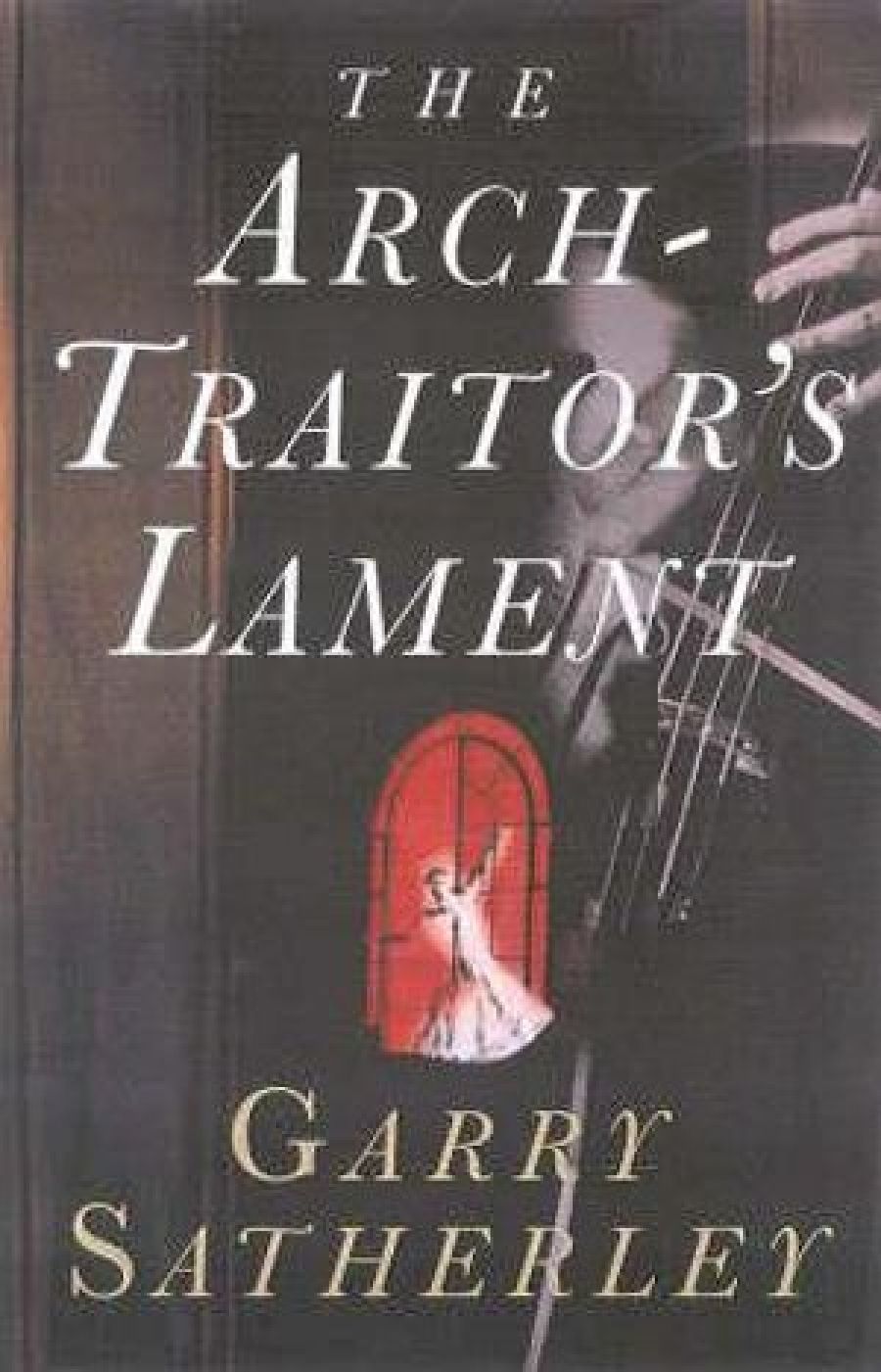
- Free Article: No
- Contents Category: Fiction
- Review Article: Yes
- Online Only: No
- Custom Highlight Text:
The note from Text’s publicist read: ‘Hope you enjoy this.’ I did. I did. (I read it twice.) The note continued: ‘There’s no other Australian novel quite like it.’ I couldn’t quite bring myself to agree with that. Garry Satherley’s (as in ‘satherley buster’, no doubt) first novel suggests, to my perhaps over-convoluted consciousness, Murray Bail’s Homesickness, Anthony Macris’ Capital: Volume 1, Glenda Adams’ Dancing on Coral and, drawing a long bow, Henry Handel Richardson. I will let Text Publishing and anyone else interested chase up the resemblances, which are casual rather than causal. That The Arch-Traitor’s Lament more pertinently suggested to me Czech novelists such as Josef Škvorecký and Ivan Klíma, for example, was a different matter, they not being Australian, and they have earned their right to their political fictions on the decks of those two dreadnoughts, hardship and censorship. That was my grumpy not-quite-convinced first reading. My second reading convinced me that Satherley was doing something quite different from the Iron Curtain callers. He was writing an Australian novel (well, he was born in New Zealand, but we are masters of ethnic appropriation across the Tasman) with European facts and fictions as pan of its subject matter.
- Book 1 Title: The Arch-Traitor’s Lament
- Book 1 Biblio: Text, $27.50 pb, 308 pp
For there are two stories in this novel, only one of which is the ‘arch-traitor’s lament’. The other is the decline and fall of an Australian, Steve Sankey, who finds himself, due to engine failure on his Qantas Boeing – unthinkable! – adrift, lost, imprisoned, doomed in the arch-traitor’s country, ‘a very small republic between Hungary and Romania’. Very small, but very inescapable too. The arch-traitor is Kukac Janos whose name, as that inside-outside man Andrew Riemer has helpfully pointed out in the Sydney Morning Herald, not only comes with surname first in accordance with the peculiarities of Hungarian nomenclature, but whose surname means, in Hungarian, ‘maggot’. In this terminally grim political landscape, which mimics not only that of post-1933 Czechoslovakia – once Bohemia, now the Czech Republic – Steve Sankey, former almost Olympian swimmer, master of the rugby sidestep, becomes Senki Istvanor ‘Steven Nobody’. So this novel is both an arch-traitor’s lament and the diary of a nobody.
Satherley, who I understand spent some time in Budapest, has really chosen to go fifteen rounds with the Muhammad Alis of Iron Curtain satirical (if that be an adequate word) fiction, and he succeeds wonderfully well in this hubristic enterprise. His portrayal of the grimnesses of Nazi and ‘Szovi’ occupied states, of betrayals and violences, the absurdity of prosecuting ‘culture’ in such circumstances – Kukac Janos is a double-bass player, who drags his intractable ‘Accursed’ everywhere he goes – and the all-pervasive power of betrayal is most effectively and affectingly done. And he somehow manages to get away with the odd bizarre Australian joke – the arch-traitor’s best friend’s rooftop ‘flying machine’ can be nothing other than a Hill’s Hoist which, along with the wine cask, is one of Australia’s greatest inventions. The appearance of the (unnamed) Hill’s Hoist in ‘Budapest’ is no less bizarre than Murray Bail’s observing from the deck of a container ship near Rotterdam: ‘Man in park alongside river throwing a boomerang.’ Another great Australian invention.
While I found Steve Sankey’s story – Bad-Boy Businessmen Down Under or Candid in the Colonies – less interesting than Kukac Janos’ or Senki Istvan’s story, the fact of the antipodean tale is crucial to the symmetry and differences of Satherley’s novel. It seemed to me on my second reading that the Iron Curtain narrative, reminiscent of Škvorecký and Klíma and perhaps early Kundera, served to underline the innocence and ease of contemporary Australian existence (Aboriginals and asylum seekers excluded). The contrasts between Iron Curtain and Lucky Country (Donald Horne eternally misunderstood), between the Isle of the Dead and the Land of Lotus Eaters, between warm beaches and freezing dachas, between the Hotel Karl Marx, later the Hotel Diszno (after the dictator) and Disneyland on the Gold Coast, though never insisted upon, are always present. In a sense, a very important sense, the ‘otherness’ of the narratives in The Arch-Traitor’s Lament is always testing its Australian readers, keeping them on the edge, encouraging them to run the risk of self-betrayal.
I understand that separate large slabs were taken on two occasions from the manuscript of this novel, and this may account for my sense that the end of the book, the ‘Coda’, is less than clear, less than firm. But Senki Istvan does say something firm and clear about Australia in this coda:
Maybe he would never go back. Its grip on you seemed so feeble, that Ooze-tralee, that monstrous empty island, with its people clinging to the ragged margins. This life he was living now, it was his own. It wasn’t so important that you were cold and hungry, he thought. I am here now. I am of these people now.
Even if they were crazy.
A high price has been paid for Authenticity. On the evidence of The Arch-Traitor’s Lament I wish simply, in conclusion, to salute its author’s debut by singing: ‘Blow the wind Satherley, Satherley’, accompanied, of course, on the double-bass.


Comments powered by CComment